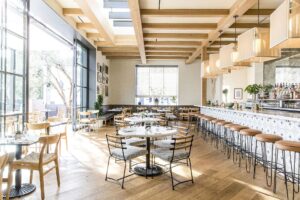In the competitive landscape of the hospitality industry, hotels are constantly seeking innovative ways to attract guests and provide exceptional experiences. While accommodations and services are primary factors influencing guests’ choices, the integration of a well-designed restaurant within a hotel has become a pivotal element in shaping the overall guest experience. The symbiotic relationship between hotel and restaurant design goes beyond aesthetics; it directly impacts guest satisfaction, influences revenue streams, and contributes significantly to a hotel’s success.
Creating a Distinct Identity
A restaurant within a hotel serves as more than just a dining space; it establishes a unique identity for the property. Design elements such as interior decor, lighting, furniture, and ambiance play a crucial role in setting the mood and differentiating the restaurant from competitors. Whether it’s a fine-dining establishment, a casual eatery, or a themed café, the design should align with the hotel’s overall brand image while offering an independent and memorable experience for guests.
Enhancing Guest Experience
The design of a restaurant directly impacts the guest experience. Thoughtfully planned layouts, comfortable seating arrangements, and appealing aesthetics contribute to a welcoming and enjoyable atmosphere. Factors like acoustics, lighting, and décor significantly influence the mood and comfort of guests during their dining experience, ultimately affecting their overall perception of the hotel.
Maximizing Revenue Potential
A well-designed restaurant can become a significant revenue driver for a hotel. Beyond providing a convenient dining option for guests, a visually appealing and strategically designed restaurant has the potential to attract external patrons, increasing foot traffic and revenue. Effective space planning, versatile seating options, and an enticing ambiance can encourage guests to spend more time and money within the hotel premises.
Culinary Showcasing and Innovation
Restaurant design serves as a platform to showcase culinary excellence and innovation. An open kitchen concept or chef’s table can engage guests, offering them a glimpse into the culinary expertise while elevating the dining experience. Design elements that highlight local cuisine, seasonal offerings, or unique dining experiences contribute to creating a lasting impression on guests, encouraging return visits and positive reviews.
Adaptability and Flexibility
The adaptability of restaurant design is crucial in catering to various guest preferences and changing trends. Versatile spaces that can accommodate private events, themed nights, or adapt to different meal periods (breakfast, lunch, dinner) ensure optimal utilization of the restaurant space. Flexibility in design allows hotels to evolve with guest demands, ensuring sustained relevance and appeal.
Technology Integration
In the modern era, technology plays a vital role in enhancing the dining experience. Integrating technology seamlessly into the restaurant design, such as digital menus, mobile ordering, or interactive displays, can streamline operations, improve guest convenience, and elevate the overall dining experience.
Conclusion
The integration of a well-designed restaurant within a hotel is a strategic imperative in the hospitality industry. Beyond merely serving meals, a thoughtfully curated restaurant design enhances guest experience, drives revenue, and reinforces the hotel’s brand identity. By creating unique and inviting spaces that cater to diverse guest preferences, hotels can establish themselves as destinations of choice, fostering loyalty and ensuring sustained success in an increasingly competitive market.
In summary, the careful consideration and investment in restaurant design within hotels are indispensable in creating memorable guest experiences, fostering revenue growth, and establishing a distinguished position in the hospitality landscape.


